Pattern Material In Casting Process
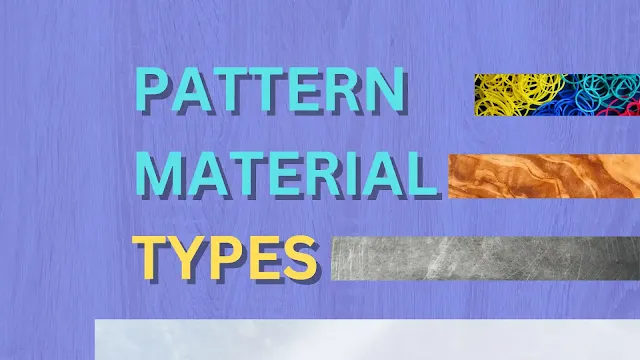
|
| Pattern Material In Casting |
When it comes to producing products using the sand casting process, investment casting process and shell moulding process selection of pattern material becomes a crucial step for producing sound casting.
Depending upon the application of the casting, size, cost, shape, weight, defects, storage, volume of casting to be produced, production cost and order pattern material are selected.
Various types of pattern material are used in the foundry for making a pattern.
I have explained various pattern materials used in pattern making in detail below with application, uses, advantages and disadvantages of pattern materials.
Students are advised to go through the following pattern materials used in sand casting, shell moulding and investment casting process for producing patterns.
{tocify} $title={Pattern Material In Casting Table of Content }
Pattern materials examples used for pattern making in the casting process are as follows:
- Wood.
- Metal.
- Plastic.
- Plaster.
- Wax.
- Rubber.
- Fibreglass.
- Polyurethane foam.
- Metal alloys.
Wood As Pattern Material
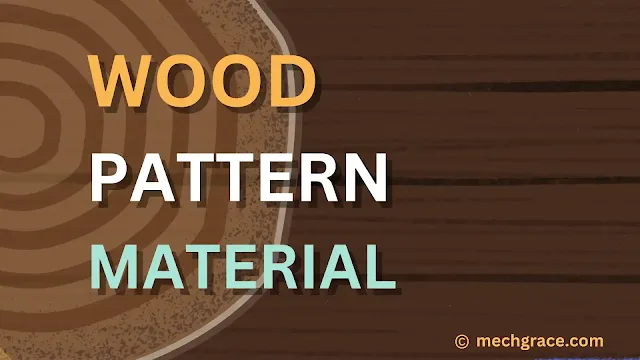
|
| Wood Pattern Material |
Wood is the most common material used for making patterns in casting.
The wood used for making patterns should not have knots and should be straight-grained.
The wood used in the pattern should be dried. Moisture in the wood pattern will cause warping and distortion during the drying of the wood pattern.
Plywood boards (engineered wood) are composite material wood which finds applications and uses in sand casting process for producing segmental pattern, follow board pattern, skeleton pattern and sweep pattern as they are available readily at smaller thicknesses and can be easily workable as they have high strength.
These boards have higher shear strength, bending and compression strength.
Particle boards are used for producing small-size patterns such as single-piece and split-piece patterns as this wood does not have the strength and can break due to sand ramming force.
Varnish and paints should be applied for the long life of the wood pattern.
Wood such as White pine, Mahony, Maple, Cheery, Birch, C.P.Teak, Deodar, Sugar pine, Kail, Shishma and Bruma is used for producing wood patterns in the sand casting process.
Maple and Cherry wood: This wood is widely used for making small patterns as it has the drawback of warping as it absorbs moisture easily.
White Pine: It is a widely used wood for making patterns because it is easy to work, light in weight, straight-grained, soft and warps less.
Mahogany: It is durable and harder than white pine with less warping ability.
The application of wood pattern is used for manufacturing a small number of casting used to make single-piece pattern, split pattern, skeleton pattern, and segmental pattern.
Wood pattern material requirement.
- It should be free from knots.
- Free from the sapwood.
- Easy to work on a lathe.
- Straight grains.
- It should be strong.
- Should not wrap while drying.
- Should have a smooth surface.
- Should be cheap and easily available.
- Should not have a moisture of more than 10%.
Wood Pattern Advantages
Advantages of wood patterns are as follows:
- Light in weight as compared to the metal pattern.
- Easily available and easy to work with.
- Wood can be bent, curved, made smooth and glued together.
- Easy to handle in the foundry.
- Expensive compared to metal patterns of the same size.
- The workability of wood material is better.
- Wood as a patterned material is easy to repair.
Wood Pattern Disadvantages
Disadvantages of the wood patterns are as follows:
- Wood is affected by moisture in the sand.
- Wood shape and foam change with moisture content.
- In green sand, moulding moisture is absorbed by the wood pattern.
- The pattern warps after it has dried.
- Wood patterns wear more than metal patterns due to sand abrasion.
- Resin should be used to fill the cavities to make them denser.
- Needs to be preserved in shellac.
Metal As Pattern Material In Casting
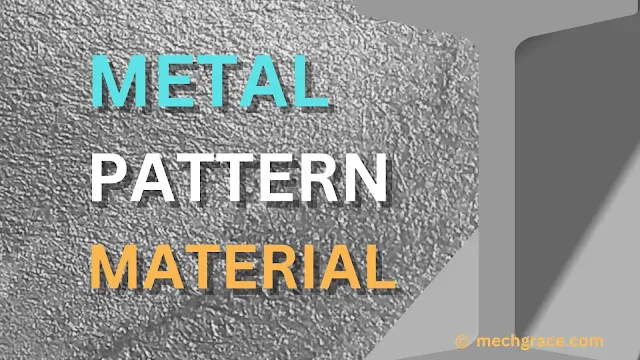
|
| Metal Pattern Material |
Metal patterns are either cast from sand casting using a wood pattern or machined to foam a metal pattern by machining.
Metal patterns are used in machine moulding.
Most commonly used metal for making metal patterns are as follows:
- White metal.
- Cast steel.
- Brass
- Aluminium alloy.
- Cast iron.
- Steel.
White metal: White metal is a lightweight metal that is easily machinable having a low melting point with few drawbacks such as wear abrasion.
The white metal can be used for patterns without a double shrinkage allowance.
The white metal is soft and can be used for small patterns only. Pattern parts are soldered together.
Brass: Brass is an expensive metal that is soldered and brazed to make small smooth patterns.
Aluminium: Aluminium is a lightweight corrosion-resistance metal used to make medium to large-size casting, Aluminium comes with shrinkage and wears abrasion drawbacks.
Cast iron: Cast iron as a metal pattern has a fine structure and is more durable than aluminium.
Cast iron is heavy, prone to corrosion, and has a high melting point.
Cast iron is exactly the opposite of aluminium. Is difficult to work with but is cheaper than aluminium for the metal pattern.
Double shrinkage allowance needs to be considered if the pattern is made of metal.
Shrinkage allowance and machining allowance apply when metal as pattern material is used.
What is the most common material used for making metal pattern?
Aluminium is the most common metal pattern material.
Metal Pattern Advantages
Advantages of metal pattern are as follows:
- Metal patterns are more durable than wooden pattern material.
- Used for large-scale production because they wear less and tear less.
- Multiple mould cavities can be made with close dimensional accuracy.
- The dimensional accuracy of metal patterns is higher than that of wood patterns.
- The smooth surface finish is compared to the wood pattern material.
- The metal pattern material does not change the dimensional and wraps with moisture.
- Metal material is resistant to abrasion and swelling.
- Able to facilitate rough and tough handling.
- Non-ferrous metal patterns do not rust even after coming in contact with moisture in the sand.
- Patterns can be stored for a longer time without change in dimension as compared to wood, wood and plaster patterns.
- The machinability of metal patterns is better than wood pattern material.
Wood Pattern Disadvantages
Disadvantages of the metal patterns are as follows.
- The cost of metal patterns is higher than that of wooden and plastic patterns.
- Ferrous pattern rust and are not corrosion resistant.
- Metal patterns are heavy to handle in the foundry.
- The pattern is difficult to repair and needs special attention for maintenance and service.
- Machining cost is higher than any other pattern for producing complex casting as CNC machines need to be employed.
Plastic As Pattern Material In Casting
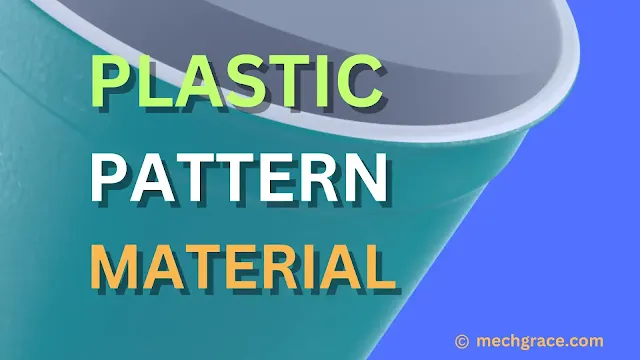
|
| Plastic Pattern Material |
The plastic pattern is a lightweight material which provides high dimensional accuracy, and a better finish, is easy to handle and can produce complex shapes in the sand casting process.
Plastic patterns are low-cost patterns that can be made from injection moulding by injecting plastic into the die and layering with resin and fibre.
Plastic patterns are also made by pouring plastic in plaster of paris mould and giving the shape.
Laminated plastic patterns are more durable, and resistant to wear and tear than the wood pattern.
A combination of epoxy, resin, PVC, fibreglass and other materials can be added to make the pattern more suitable for creating mould cavities in the mould.
Cold-setting epoxy resin with suitable fillers is the best plastic for pattern material.
Plastic materials with the following combination are used for producing a plastic pattern in casting:
Combination of epoxy, acrylates, polyvinylchloride, phenol formaldehyde, polyester resins, polyethene and polyacrylates.
Plastic Pattern Advantages
Advantages of plastic patterns are as follows:
- Plastic material is lighter in weight than wooden and metal patterns.
- Plastic has good foamability.
- Plastic has better design flexibility for producing complex patterns.
- The cost of plastic material is low.
- Plastic material is resistant to corrosion.
- The plastic pattern does not warp with moisture as compared to the wooden pattern.
- Has better dimensional accuracy for complex parts.
- Better smooth and fine surface finish.
- Easy to handle as compared to metal and wood patterns.
- Easy to repair and has durability.
- A double shrinkage allowance is not required for the plastic pattern.
Plastic Pattern Disadvantages
Disadvantages of plastic pattern are as follows:
- Plastic patterns can be fragile while sand ramming.
- Not feasible to produce a pattern in low volume using injection moulding.
- Has lower strength than metal pattern material.
Plaster As Pattern Material

|
| Plaster Pattern Material |
Gypsum patterns are made by pouring a slurry of plaster into the mould-producing master pattern.
These gypsum patterns are used for producing casting with complex shapes, close tolerance and intricate details.
Plaster of Paris and hard metal casting plaster are two types of gypsum used for making patterns.
Gypsum is soft, mouldable, and has the plasticity to foam any shape best suitable for producing intricate casting.
Follow boards are made from the plaster in moulding.
A few types of gypsum plaster are as follows:
- Hydrocol.
- Hydrostone.
- Ultracal.
Plaster Pattern Advantages
The advantage of plaster as a patterned material is as follows:
- It has higher compressive strength than wax, wood, foam and plastic pattern material.
- Has good storability quality.
- The cost is lower than the metal pattern and offers good quality pattern material flowability.
- Complex shapes can be produced better than wood pattern material.
- This material is widely used in the shell moulding process to produce shell mould.
- The coefficient of expansion of the pattern material is low.
Plaster Pattern Disadvantages
- Expands after the solidification of the slurry.
- A skilled technician is required to work with this material.
- This material cannot be used for producing large-size patterns.
- A proper consistent mixture of plaster paste and liquids is required to make perfect plaster material.
- The formation of bubbles/air in the slurry can make the pattern structurally weak.
Wax As Pattern Material
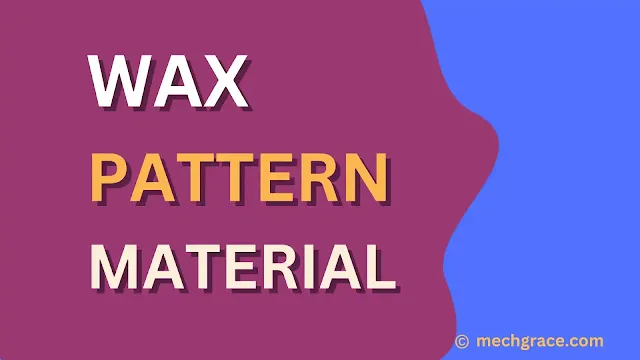
|
| Wax Pattern Material |
Wax is used as a pattern material in the investment casting process.
Wax has a high mouldability producing complex shape wax patterns.
Wax should have the following properties to use as a pattern for casting.
- Low ash content.
- Weld strength.
- Better tensile strength.
- Hardness.
Wax is melted and poured into a split die to produce a pattern with high dimensional accuracy.
Different types of wax used for producing wax patterns are:
- Shellac wax.
- Camauba wax.
- Cerasin wax.
- Bees-wax.
- Paraffin wax.
Wax Pattern Advantages
- A good surface finish is produced by a wax pattern.
- This pattern is similar to the foam pattern, the wax pattern is not taken out from the mould cavity (Pattern withdrawal is not required).
- The wax pattern has higher accuracy than the wood pattern.
- Casting with very close dimensional accuracy, tolerance and good quality can be produced.
- The pattern in mould takes less time and temperature to drain out of the mould.
- Complex casting shapes with edges, corners, cuts and thin sections can be easily produced.
Foam As Pattern Material
When there is no need to withdraw patterns from the mould pattern material such as foam is used for producing small-size casting.
This foam pattern gets burned in the mould itself during the sand-casting process. Types of foam used in sand casting is polyethene form.
Foam Pattern Advantages
Advantages of using foam as a patterned material are as follows:
- The foam is light in weight as compared to all other patterns in the casting process.
- The foam is easy to shape.
- Easy to handle as it is light in weight, and does not require any special equipment to handle the foam in the foundry.
- The cost of the foam is less as compared to wood, metal, plaster and plastic pattern material.
- Pattern withdrawal from the sand mould is not required.
Foam Pattern Disadvantages
- The foam absorbs moisture in the green sand mould.
- Can be used only for small-size casting.
Pattern Material In Casting MCQ (Multiple Choice Questions & Answers)
1) Which of the following patterns is not taken out of the sand mould and gets evaporated when it comes in contact with the molten metal in the casting process?
2) Which pattern material can produce the most complex shapes in the casting process?
3) Which of the following pattern materials used in the casting process is the most structurally stronger?
4) Which of the following qualities does a metal pattern have compared to a wood pattern?
5) Patterns are used for producing casting in direct or indirect ways using which of the following casting processes?
Pattern Material In Foundry Summary
Depending upon the type of casting to be manufactured in the manufacturing process pattern material is selected.
The most common materials used for pattern making are wood and metal (aluminium).
The material used for making patterns in investment casting is wax.
There are 17 types of patterns that are used in the casting process using various pattern materials.
Pattern materials used for pattern making are wood, metal, metal alloys, plastic, wax, gypsum, rubber and polyurethane foam in the sand casting process.
Pattern material is selected based on various factors that I have discussed in selecting of pattern material in casting article.
The selection of pattern material also depends upon the properties of pattern material that I have discussed in the properties of pattern material in casting article.
